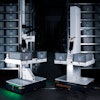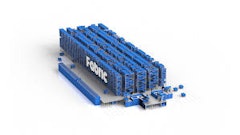
In today’s fast-paced e-commerce environment, the last mile of delivery has become a major cost driver, accounting for over 50% of total delivery expenses. This segment is also highly variable due to geography, traffic, and population density. As customers expect faster, more reliable delivery, businesses are optimizing last-mile networks through strategic fulfillment center placement and technologies like AI and machine learning. Key factors such as customer proximity and demand density play a vital role in boosting efficiency, cutting costs, and improving satisfaction. Here’s how these elements, along with innovations like micro-fulfillment centers (MFCs), are transforming modern logistics.
Why customer proximity matters
The last mile of delivery, the final leg from a fulfillment center to the customer’s doorstep, can account for over 50% of total delivery costs. This segment is also the most variable, influenced heavily by geography, population density, traffic conditions, and delivery method. By locating FCs closer to where demand originates, businesses can reduce shipping distances and costs, improve delivery speed and reliability, and increase customer satisfaction and loyalty. Proximity also plays a role in reducing environmental impact. Shorter delivery distances lower fuel consumption and emissions, contributing to corporate sustainability goals, a factor of growing importance in both consumer perception and regulatory compliance.
Understanding demand density
Customer proximity must be paired with demand density, or the concentration of order volume in specific regions. High-demand areas enable more efficient delivery through denser routes, better driver utilization, and lower costs per package. To assess demand density, businesses should analyze order patterns using metrics like daily orders by zip code, order frequency, repeat rates, SKU velocity, and category trends. Factoring in seasonality and peak fluctuations is essential. Visual tools like heatmaps and clustering algorithms can highlight demand hotspots and inform strategic fulfillment center placement.
This data-driven approach to demand density is not just operationally advantageous, it’s a strategic imperative in the context of a broader industry shift from centralized to decentralized fulfillment networks. Historically, fulfillment strategies relied on large, centrally located distribution centers designed for nationwide shipping. However, this model increasingly fails to meet modern consumer expectations for speed and flexibility. Nearly 56% of online shoppers aged 18–34 expect same-day delivery, with 61% willing to pay extra for this service. Additionally, 97% of consumers now consider same-day shipping the benchmark for "fast" delivery, highlighting a relentless demand for speed.
As a result, many businesses are adopting decentralized networks, where inventory is distributed across multiple regional or local nodes. In this model, inventory is positioned closer to demand, allowing facilities to operate more nimbly and focus on high-turn SKUs. Orders can then be dynamically routed to the nearest node with available stock, enhancing both service levels and cost efficiency.
Micro-fulfillment centers: A new paradigm
MFCs are compact, automated facilities (10,000–50,000 square feet) near urban hubs, enabling sub-two-hour to same-day delivery of high-demand SKUs. Often integrated into retail or dark stores, they support hyperlocal demand with efficient, automated operations. As consumer expectations for delivery speed rise, MFCs offer strategic advantages: urban proximity, faster replenishment, lower labor costs, and seamless omnichannel integration (home delivery, BOPIS). Their modular design enables scalability for rapid expansion, seasonal surges, and market testing. MFCs are especially effective in grocery, pharmacy, and general merchandise, where fast, reliable fulfillment is critical. The global MFC market, valued at $6.2 billion in 2024, is projected to grow to $31.6 billion by 2030 (CAGR 31.1%).
Strategic framework for decision-makers
An effective fulfillment center location strategy begins with a clear customer promise, whether that is next-day delivery, same-day service, or cost-efficient shipping, and this commitment shapes all planning decisions. Demand patterns and customer geography must be analyzed to pinpoint high-density zones and growth areas, using tools like GIS, heatmaps, clustering algorithms, and machine learning forecasts.
Once demand is mapped, planners must evaluate end-to-end costs including transportation, labor, real estate, and utilities to optimize total landed cost while maintaining service levels. In dense urban areas, MFCs help reduce last-mile costs and boost speed by complementing larger hubs. Rather than just placing warehouses, the focus is on strategic, data-driven planning to optimize speed, scale, and cost.
A tiered structure is key: regional distribution centers (RDCs) manage bulk storage, while localized fulfillment cetners and MFCs handle last-mile delivery. This ensures inventory is positioned based on demand and SKU velocity. Customers now expect fast, seamless experiences across eCommerce, B2B, and retail. Meeting this demand requires integrated capabilities like ship-from-store, curbside pickup, and gig delivery—enabled by tech platforms (OMS, DOM, TMS) for real-time decision-making.
Built-in resilience is essential. Flexible networks with alternate carriers, buffer capacity, and scenario planning help withstand disruptions and adapt quickly to change. Scenario planning ensures resilience and scalability by preparing for disruptions and demand shifts. Key performance indicators (KPIs) like delivery speed and cost per order drive continuous improvement and smarter decisions.
In conclusion, optimizing last-mile delivery through strategic fulfillment center placement, driven by customer proximity and demand density, is key to meeting the evolving expectations of modern consumers. By leveraging technologies such as AI, machine learning, and micro-fulfillment centers, businesses can enhance delivery speed, reduce costs, and improve overall customer satisfaction. As e-commerce continues to grow, companies must adapt to shifting consumer demands by embracing decentralized fulfillment models and integrating cutting-edge solutions. Ultimately, a well-designed fulfillment network that balances cost, speed, and efficiency, while remaining resilient to external challenges, will be essential for businesses to thrive in the competitive landscape of the future.

















